A behind-the-scenes look at Green Mountain Spinnery’s high-quality yarns and sustainable business practices
STORY BY BENJAMIN LERNER
PHOTOGRAPHY BY JIMMY IENNER, JR.
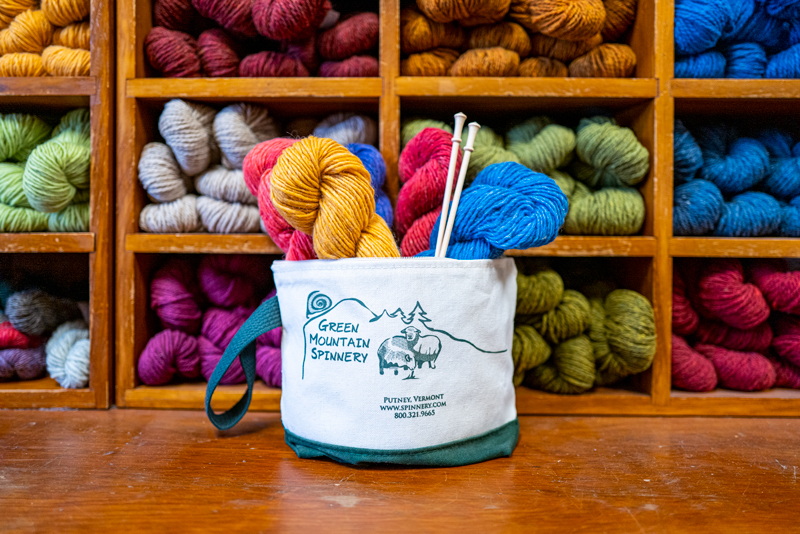
In the charming town of Putney, an independent, worker-owned spinning mill stands near the winding banks of the Connecticut River. Upon arriving at Green Mountain Spinnery, fiber enthusiasts, knitters, and crocheters will find an inviting storefront that is replete with high-quality yarns, informative pattern books, and knitting accessories. Visitors who come to Green Mountain Spinnery are able to participate in guided tours of the rooms directly behind the shop, where a tightly-knit team of passionate workers careful- ly processes a wide array of natural fibers (such as wool, alpaca, and mohair, among others) into beautiful yarns with masterful efficiency. By making use of environmentally-sustainable methods, they carry on the tradition of ethical business stewardship that was passed down to them by Green Mountain Spinnery’s original founders.
A Fascinating Yarn
In the mid-1970s, a group of kindred spirits living in the greater Brattleboro area began a conversation that would profoundly influence the trajectory of their lives—and eventually lead to the founding of Green Mountain Spinnery. The group was comprised of a journeyman weaver by the name of Claire Wilson, a teacher named Libby Mills (who founded the fiber program at the nearby Putney School) and two graduates of Brattleboro’s School for International Training, David Ritchie and Diana Wahle.
After the four of them extensively dis- cussed E.F. Schumacher’s groundbreaking book, Small is Beautiful: Economics as if People Mattered, during a study group meeting, they began to explore the possibility of banding together to start a small business. As their plans continued to develop, they became united in the mission of revitalizing their community through a thoughtful and conscientious independent enterprise.
Drawing on the lessons that they had learned from closely studying Schumacher’s book, they envisioned a business model that would create opportunities for local small-scale farmers while making sustainable and responsible use of natural resources. After an extended period of planning and review, the four friends decided to build a spinning mill that processed fibers sourced from regional farms into yarn. At the time, many of New England’s dairy farms were downsizing due to changes in the United States’ agricultural economy. Coincidentally, the 1976 Oil Embargo had directly influenced a sharp uptick in the price of petroleum-based yarns, which perfectly set the stage for their nascent business. They understood that by working directly with small fiber farms, they would be able to provide a cost-effective and environmentally-friendly alternative to the petroleum-based yarns that were dominating the market. In the process, they would contribute to the overall growth of small farm operations in the greater New England region. They would also improve biodiversity by directly influencing the healthy proliferation of the heritage breed animals from which the fibers were sourced.
With their plans in motion, Wilson, Mills, Ritchie, and Wahle traveled far and wide to conduct in-person research over a four-year period. Their journey took them to spinning mills all around New England and Europe, where they learned time-tested yarn processing methods first-hand. During the course of their travels, they partnered with a skilled and established mill technician named Ray Philips, who worked at Harrisville Yarns in nearby Harrisville, New Hampshire.
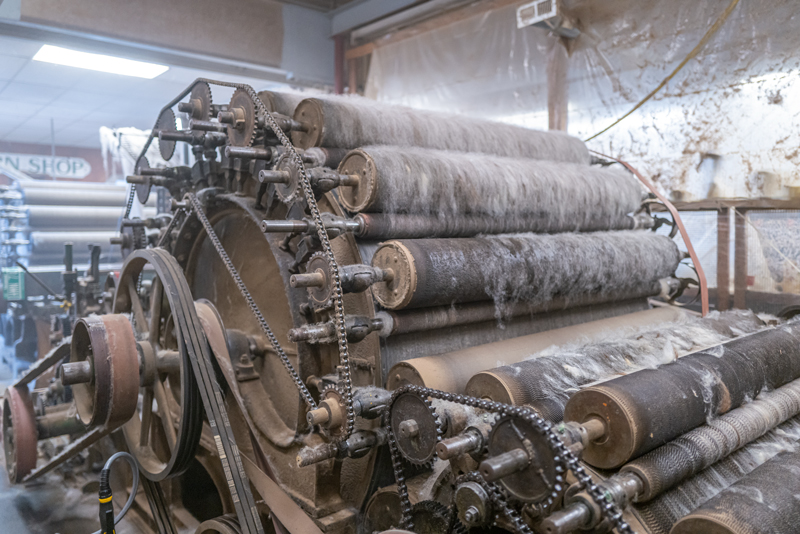
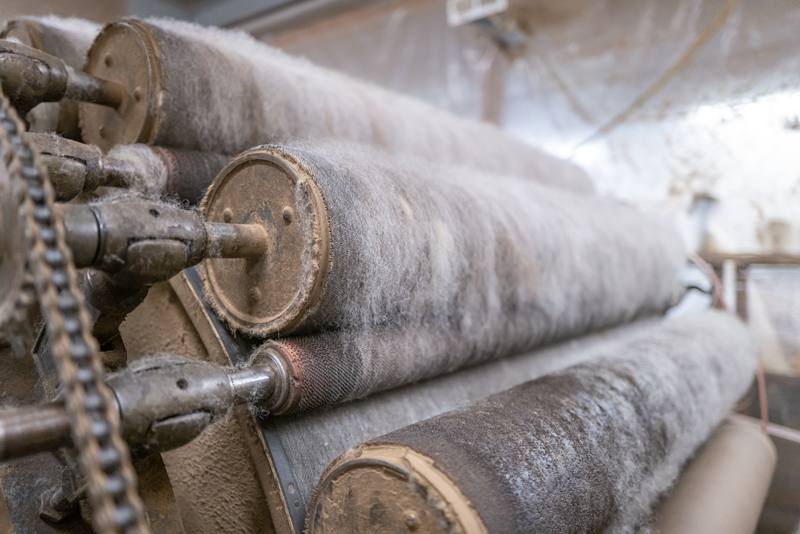
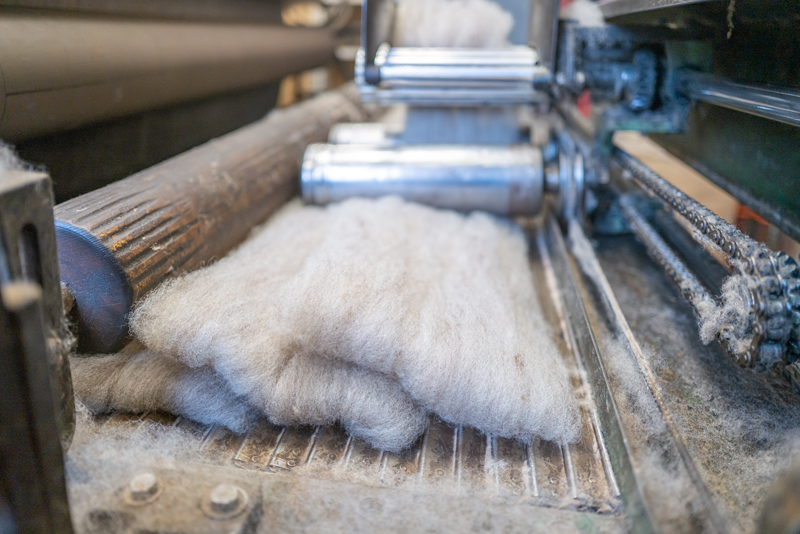
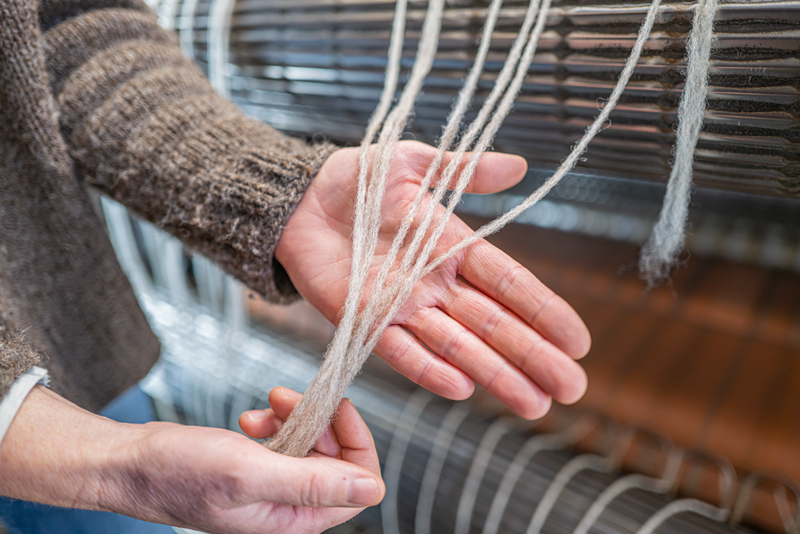
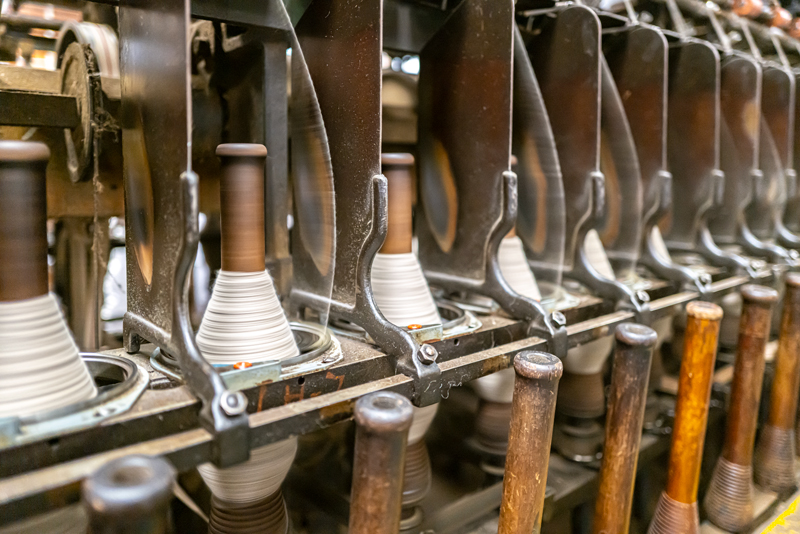
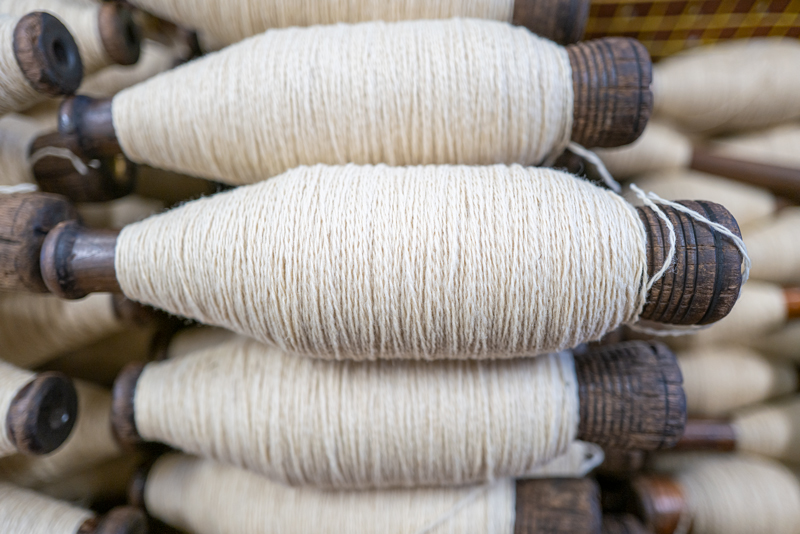
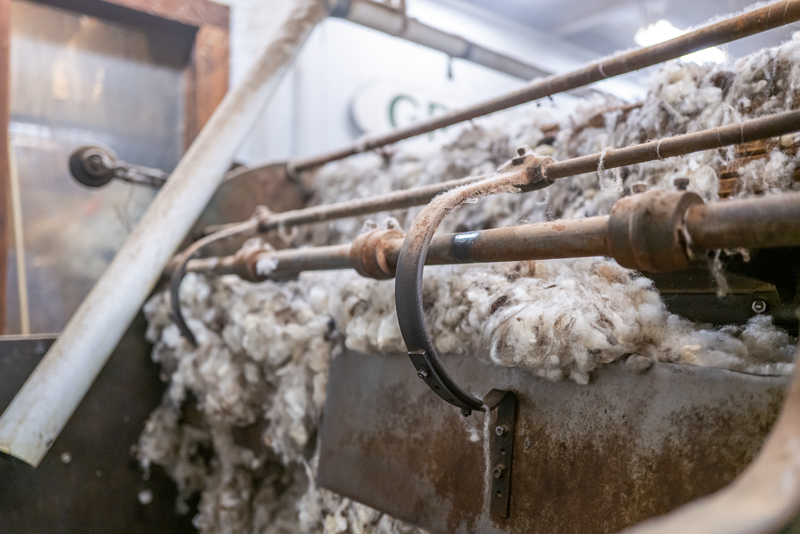
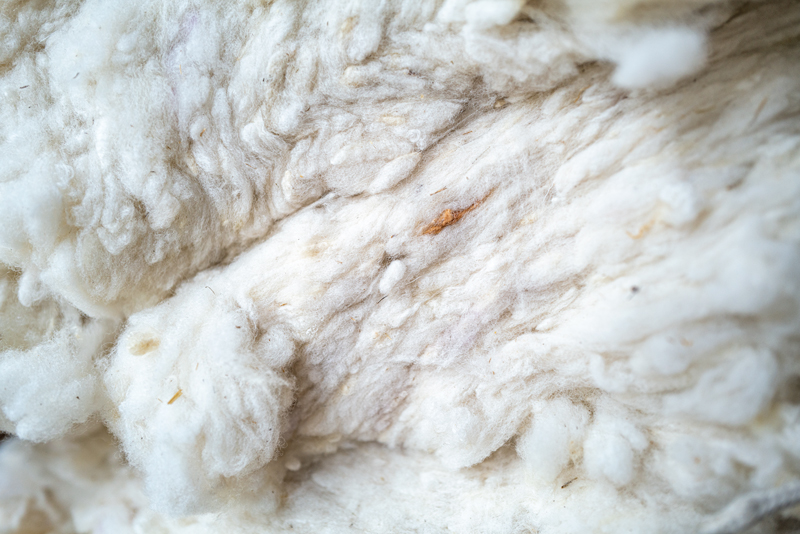
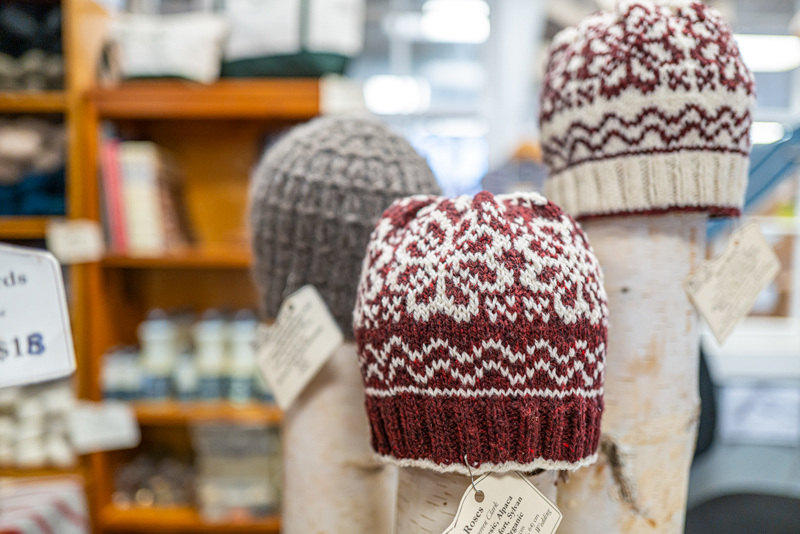
Working closely with Philips, Green Mountain Spinnery’s founders were able to find all of the machinery that they needed to open the shop. After acquiring the machinery, Wilson, Mills, Ritchie, and Wahle purchased a building that formerly housed a gas station in southeastern Putney. Once the building was renovated, a functioning production floor was assembled. Green Mountain Spinnery was officially founded and incorporated in 1981, and production began that same year. A year after Green Mountain Spinnery first opened its doors, Philips joined the team and started supervising their production process. His mentorship not only enabled the founders of Green Mountain Spinnery to move forward with their budding venture, but also helped them navigate a series of complicated technical issues with the machinery. Under Philips’ tutelage, replacement parts were sourced from machines from larger mills in New England that were closing down, as well as tractors, elevators, and motorcycles. With every passing year, the team’s skills continued to improve, allowing them to forge fruitful partnerships with fiber farmers throughout the region.
Green Mountain Spinnery was founded as a worker-owned cooperative guided by the proliferation of similar co-op businesses in Mondragon, Spain. In line with Green Mountain Spinnery’s core values of collective empowerment and community betterment, their democratic cooperative workplace model allows every employee to have a voice in the day-to-day operation of the business. Every big and small decision that impacts the organization is made on the basis of universal consensus, creating a healthy workplace where employees are supported and respected. Green Mountain Spinnery still operates under a cooperative ownership model to this day, and their employees remain committed in their unrelenting efforts to continuously improve the quality of their yarns.
A Well-Oiled Machine
Just as every employee at Green Mountain Spinnery plays a crucial role in the prosperity and vitality of the organization, every machine in their workshop plays a critical part in the production process. Almost all the fiber that comes to Green Mountain Spinnery is sourced from North America, including the wool that is used in many of their yarns. For the wool yarns, the manufacturing process begins with a “scouring” stage, which removes the dirt and lanolin from the raw material. In order to make the wool fibers into yarn, the raw fibers are first soaked in a sink with hot, soapy water. When the fibers are done soaking, they are run through a series of wringers in between hot water basins, where the soap gets rinsed off. After being thoroughly cleaned, the wet fiber is placed in Green Mountain Spinnery’s extractor machine, which was built in 1896. Hot water is sprayed on the fibers while the machine’s drum spins. The fibers are then transported to an industrial dryer. A filtration system recycles the majority of the water used in the wool-washing process, reducing the overall environmental impact.
After the scouring phase is complete, the “picking” stage begins, in which fibers are opened up using a machine that separates the locks of wool. The fiber is picked several times, and is sprayed with a proprietary “spinning oil” that is made on-site with water, vegetable oil, and soap. The spinning oil moistens the fibers and prevents static electricity from developing within them, allowing the fibers to be smoothly processed by the carding machine in the next stage.
When the fiber has been satisfactorily picked, it is fed into the Green Mountain Spinnery’s Davis and Furber carding machine. Although several components of the machine have been replaced since it was originally installed, its main functional body dates back to 1916. Once the fibers are fed into the machine, rotating drums blend the fibers together, creating a fluffy sheet known as a “batt.” The batt is then separated into four different rolls, which are carried to a spinning frame where the “roving ends” of the batt are threaded by hand. The thickness of the yarn can be determined by adjusting the number of roving ends that are spun together.
Following the spinning phase, the yarn is steamed in a steaming box for two hours. From there, the yarn is sometimes threaded through a plying machine, which twists the yarn in the opposite direction than it was spun, to increase its thickness. After being steamed and plied, yarns are wound into equal length skeins. Yarns that are intended to be sold at the shop are twisted and labeled, and then go through an extensive quality control phase before making it onto the mill shop floor.
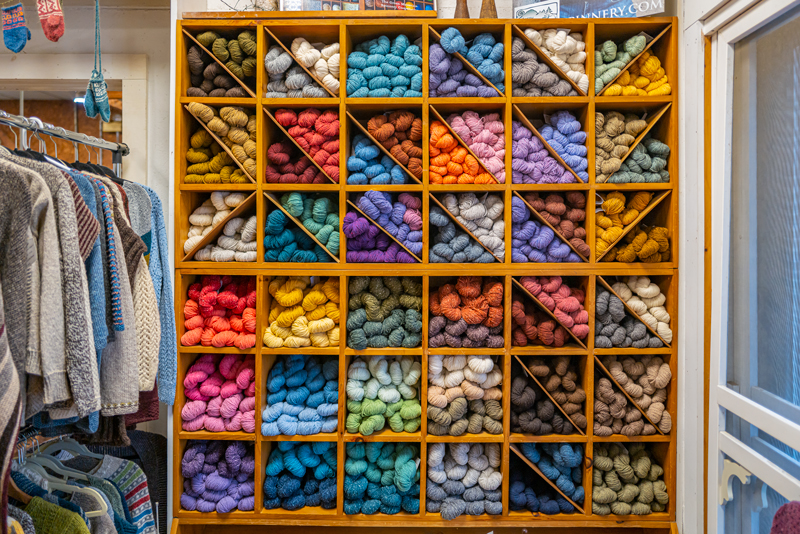
A Trip to Remember
Although all of the yarns sold at Green Mountain Spinnery are available online, fiber enthusiasts who come to visit the store in-person will be treated to a once-in-a-lifetime experience. “The best thing about visiting Green Mountain Spinnery is that we aren’t just a yarn store,” says longtime Green Mountain Spinnery team member Kate Salomon. “We are a fully-operational working yarn mill, so people who come here have the opportunity to see how yarn is created—which is a unique opportunity for most fiber enthusiasts. I had been knitting for more than a decade before I started working at the Green Mountain Spinnery, but I never gave much thought to how the yarn was made. When I visited the mill for the first time, it changed my whole perspective and elevated my knowledge of the craft.”
Those who participate in a tour of Green Mountain Spinnery are guided by one of their knowledgeable employees. Over the course of the tour, visitors gain crucial insight into the manufacturing process of the yarn from start to finish. “If a fiber enthusiast comes to visit us with friends or family members, they get a fun chance to get a behind-the-scenes look at how yarn is made. Oftentimes, that can really change their understanding of what their knitting or crocheting family member loves so much about working with fiber.”
Although Green Mountain Spinnery will happily hold tours for any visitor who comes through their doors, Salomon says that visitors should call or e-mail the shop in advance to let them know that they are coming. She adds that the best days and times to visit the shop are on Monday through Friday, 10AM to 2PM. “We have more staff here during those times that can cover the floor,” says Salomon. “That results in a better tour experience for everyone who comes to visit.” Visitors who come to Green Mountain Spinnery can also see their yarns in person, and they can try on sample garments made from the yarns to get a better sense of what they want to make. “Visitors can look at garments made from our yarns from all sides when they come here,” notes Salomon. “That can really be helpful when they’re trying to decide what pattern they want to use to make the next sweater that they want to knit. We also have a huge color range, so there are a lot of options for people to choose from.”
Two of the most sought-after yarns in Green Mountain Spinnery’s extensive collection of yarns are their “Mountain Mohair” yarn and their “New England Worsted Weight” organic yarns. “The Mountain Mohair is a very popular yarn,” says Salomon. “We’ve been making it for a long time because people love it so much. It’s a blend of wool and mohair that brings out the best of those materials. Mohair is a fiber that comes from Angora goats. It is long, curly, and very shiny. It adds luster to any yarn, and it adds quite a lot of strength to the yarn, as well. When you look at the fabric, it has a fuzzy quality that prevents it from pilling. If you’re working with a really soft wool, such as Merino wool, it has a tendency to pill. If you combine the wool with mohair, the mohair creates a buffer that makes your knitted fabric look brand-new for longer and prevents it from pilling.”
Green Mountain Spinnery’s New England Worsted Weight yarns are sourced from local farms in Vermont and Maine. “The New England Worsted Weight yarns are very popular with visitors who are interested in learning more about natural fibers and specific breeds of sheep,” says Salomon. “The yarns are all-natural and undyed, and they can be tracked directly back to the source. Everything about the yarn is organic and rustic, and it is perfect for outerwear. It’s a great yarn for New England falls, winters, and springs.”
Organic Growth
In addition to selling a broad variety of gorgeous yarns, Green Mountain Spinnery also offers custom-processing services to independent farmers and fiber producers throughout New England and beyond. By supporting the growth of small farm enterprises and integrating sustainable practices into their manufacturing process, they have built a business model that is every bit as brilliant and timeless as the gorgeous yarns that line their shop’s shelves. According to Kate Salomon, 70% of the yarn that Green Mountain Spin- nery processes is made for other small independent farmers. “It’s a big part of our business,” notes Salomon. “We are spinning wools and other fibers for people all across the country. We create a product out of the wool that they grow so that they can sell it directly to their customers. Some farmers sell their yarn at local farmstands or online, and some of them sell their yarn at sheep and wool festivals all across New England.”
Salomon adds that Green Mountain Spinnery is able to provide a unique service for farmers who grow organic wool. “Not all of the wool yarn that we produce at Green Mountain Spinnery is certified organic, but we go to extensive lengths to ensure that the manufacturing process for our organic wool is 100% organic from start to finish. We are one of the only certified organic spinning mills in the United States, and the State of Vermont has certified that all of the organic fiber that is sent to us can maintain a ‘fiber-organic’ status as it moves through our production line. We have people sending us organic fiber from as far away as Northern California, because they don’t have other mills closer to them that can do that.”
In order to maintain their certified organic status, Green Mountain Spinnery goes above and beyond to ensure that their certified organic yarns remain untouched by artificial chemicals. Salomon elaborates: “We make sure that the organic fiber never touches a surface or material that hasn’t been cleaned with organic soap. We spin our organic yarn at the beginning of every spinning cycle, moving from organic yarns to non- organic yarns with dark and bright colors. We clean all of the machinery that the fiber touches beforehand, and then we clean everything out before starting the process over again.”
All of the yarn that is produced by Green Mountain Spinnery – both certified organic and non-organic – is processed without any hazardous artificial chemicals. “There are several reasons that we don’t use harsh chemicals in our manufacturing process,” notes Salomon. “Firstly, toxic chemicals that are not disposed of properly tend to linger in nearby watersheds, which can cause extensive environmental damage. Secondly, we believe that many people whose skin is sensitive to wool fiber are actually reacting to the chemicals that are often used in the processing of the fiber. When you process the fiber as gently and as chemical-free as possible, the fiber retains more of its natural elasticity and bounciness. It actually becomes a finished fabric that is far more comfortable to wear and much more useful.”
Green Mountain Spinnery’s commitment to environmental stewardship extends far beyond their avoidance of hazardous chemicals. “Green Mountain Spinnery was founded with the goal of being able to process yarn with a minimal environmental impact, which is unusual in the textile industry. To that end, we just made a recent investment in a solar hot water system, which will help to further reduce our energy consumption. We’re trying to do what we do as efficiently as we can, while still keeping the global environment in mind. Because this is a worker-owned cooperative, we have a huge amount of pride in ownership and personal investment in our products. We really care about what we’re doing and how we’re doing it, and there’s a lot of love going into every skein that we make.”
ALL THE DETAILS

